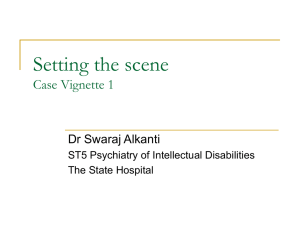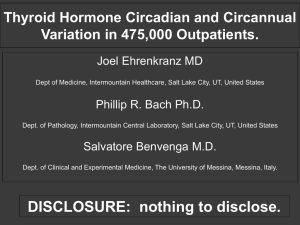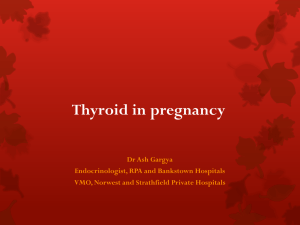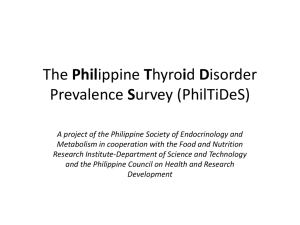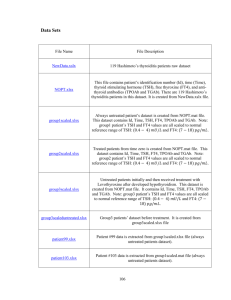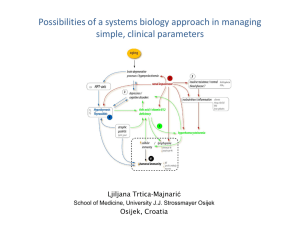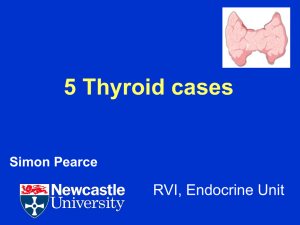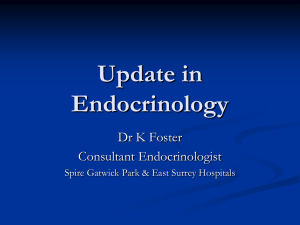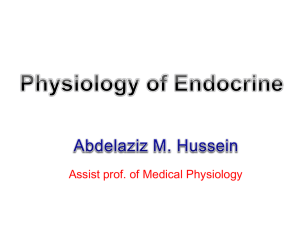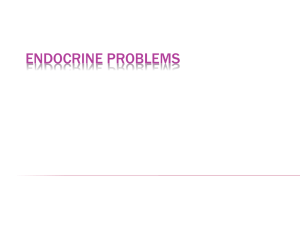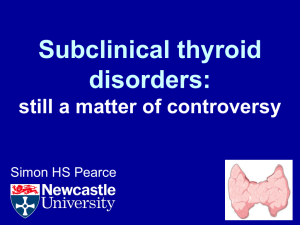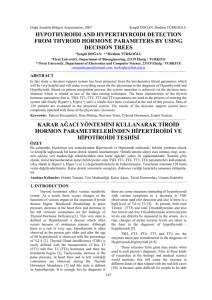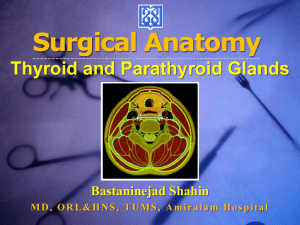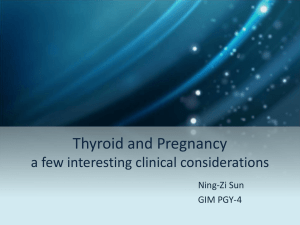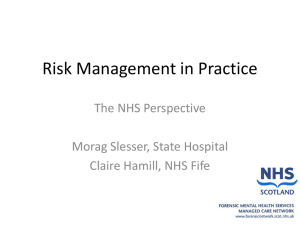Thyroid function Tests
advertisement
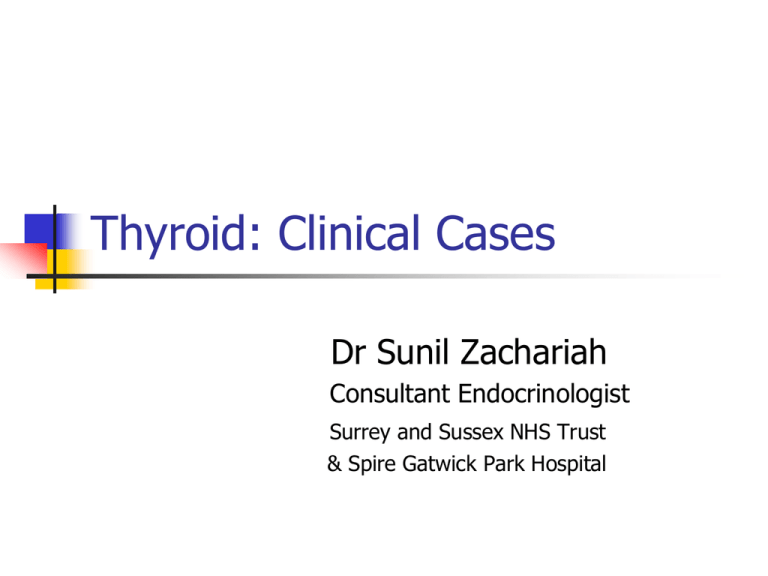
Thyroid: Clinical Cases Dr Sunil Zachariah Consultant Endocrinologist Surrey and Sussex NHS Trust & Spire Gatwick Park Hospital Thyroid is the only source of T4 Thyroid secretes 20% of T3, remainder is generated in extra glandular tissues by conversion of T4 to T3 Normal range FT4 fT3 TSH 11.5-23 pmol/l 3-6.7 pmol/l 0.3-5.5 mu/L Case 1 Female aged 40 years Palpitations, weight loss and mild proptosis Smallish smooth goitre FT4 80 TSH<0.01 Graves Disease TSH receptor antibodies Carbimazole Propylthiouracil Treatment schedule ?Block and replace Permanent cure Case 2 Female aged 76 years Gradual weight loss Solitary thyroid nodule FT4 32 TSH<0.01 Management toxic Nodule Radioactive iodine ?FNA first if palpable nodule as low risk of malignancy in toxic nodule Case 3 60 year old female 6 weeks post radioiodine treatment FT4 11 TSH 0.02 Post radioiodine thyroid function Check 6 weeks after treatment TFTs may fluctuate 50% risk of hypothyroidism Case 4 Female aged 79 years with fast AF FT4 19.5 TSH 0.2 This case probably not for antithyroid treatment If overtly hyperthyroid treat Subclinical hyperthyroidism: Normal FT4, Low TSH Risk factor for Atrial fibrillation, osteoporosis Case 5 50 year old man Ventricular tachycardia with poor LV function Controlled on Amiodarone FT4 50 FT3 7 TSH<0.01 Amiodarone and Thyroid Inhibits thyroidal iodide uptake Inhibits conversion of T4 to T3 intracellularly Inhibits T4 entry into cells Direct T3 antagonism at level of cardiac tissue What does it do to TFTs? Early[1-10 days]: TSH increase, FT3 decrease, then Ft4 increase after 4 days Later[1-4 months]: Ft4 increase by 40%, FT3 remains low or normal, TSH levels normalise Long term: TSH may suppress Amiodarone induced hyperthyroidism 2-12% Type 1: Iodine overload in abnormal gland, treat with carbimazole or lithium Type 2: Glandular damage, release of preformed hormones, treat with prednisolone 0.5-1.25 mg/kg for 3-6 weeks Management of tachyarrhythmia's: beta blockers if not in CCF ?total thyroidectomy (not radioiodine) Case 6 30 year old female Recent flu tender enlargement thyroid FT4 28 TSH<0.01 De Quervains thyroiditis Recheck TFTs-probably hypothyroid by then Thyroid antibodies and ESR Thyroid scintigram-reduced uptake Symptomatic treatment with NSAIDs Warn the possibility of recurrence Case 7 Female age 25 years Hyperpyrexia ITU admission Profound muscle weakness requiring ventilation FT4 210 TSH<0.01 Thyrotoxic crisis Carbimazole 60-100 mg via NG tube Propranolol infusion Profound myopathy and even neuropathy can be associated with Grave’s Case 8 65 year old male Pre coronary artery bypass surgery Routine blood tests FT4 3 mU/L TSH 40 pmol/L Management hypothyroidism with Coronary artery disease May need to put in stents to allow introduction of triodothyronine and then thyroxine Some patients symptomatic when thyroxine started/increased Case 9 Female aged 32 years Weight gain and thyroid FT4 13 TSH 5.5 Sub clinical hypothyroidism TSH>10 Antibody positive Family history Symptomatic Monitor TFT 6 monthly Case 10 Hypothyroid on replacement thyroxine 300 mcg FT4 23 TSH 15 Hypothyroidism requiring high dose replacement Check tablets each visit-check compliance Check for malabsorption but unlikely Probably continue to see but at infrequent intervals Case 11 Female aged 60 years Found collapsed at home History of epilepsy TFT checked in Causality FT4 8.5 TSH 4.0 Low FT4, normal TSH Sick euthyroid Possibly hypopituitary-cortisol/FSH/LH Check medication-can be secondary to carbamazepine Sick Euthyroid syndrome Non thyroidal illness syndrome Low FT4 and T3 Inappropriately normal/suppressed TSH Context: Starvation, ITU, severe infections, renal failure, cardiac failure, malignancy Case 13 Female aged 34 years Secondary amenorrhoea Low TSH Low FT4 Hypopituitarism FSH/LH/Prolactin/cortisol MRI Pitutary; ?empty fossa ?large adenoma Start hydrocortisone first if needed, before thyroxine replacement Case 14 22 year old female Admitted with hyper emesis gravidarum Pulse 110 bpm FT4 29 TSH<0.01 Management Usually HCG induced in which case it will resolve spontaneously by around 14 weeks If positive thyroid antibodies or history of grave’s disease then treat with PTU Case 14 A] Palpitations, 10 weeks post partum Ft4 32 TSH 0.2 B] Tired, 10 weeks post partum FT4 9 TSH 8 POSTPARTUM THYROIDITIS Incidence varies from 5-11% More common in women with a family history of hypothyroidism and positive TPO antibodies CLINICAL FEATURES Presentation is usually 3-4 months postpartum Can be hypothyroidism (40%), hyperthyroidism (40%) or biphasic(20%) Goiter is present in 50% of patients Pathogenesis Destructive autoimmune thyroiditis causing first release of thyroxine and then hypothyroidism as the thyroid reserve is depleted FNAC shows lymphocytic thyroiditis Diagnosis Advise routine TFT in females who have positive TPO antibodies and type 1 diabetes To distinguish from Graves disease use thyroid isotope scan and TSH receptor Ab Management Most patients recover spontaneously without requiring treatment If hyperthyroid use beta blockers rather than antithyroid drugs as the problem is increased release, not synthesis Hypothyroid phase is more likely to require treatment Only 3-4% remain permanently hypothyroid 10-25% will recur in future pregnancies Case 15 Female aged 30 years New Thyroid enlargement New Thyroid swelling FNAC if nodule size>1 cm Repeat FNAC in 6 months Impossible to differentiate between benign and malignant follicular neoplasm using FNAC Case 16 Long standing goitre FT4 28 TSH 7 Measurable TSH with raised FT4 Heterophile antibodies TSH resistance syndromes TSH oma-very rare Thyroid hormone resistance Syndrome characterized by reduced responsiveness to elevated circulating FT4 and FT3, non suppressed TSH Short stature, hyperactivity, attention deficit Differential diagnosis includes TSH secreting pituitary tumour Case 17 27 year old female Follicular Cancer of Thyroid Post surgery, post radioiodine ablation On Thyroxine replacement (175 mcg) FT4 19.8 TSH 0.05 Follow up of thyroid Cancer Original diagnosis and treatment If total thyroidectomy and ablative radioiodine, thyroglobulins usually undetectable if TSH unrecordable Maintain TSH<0.05

